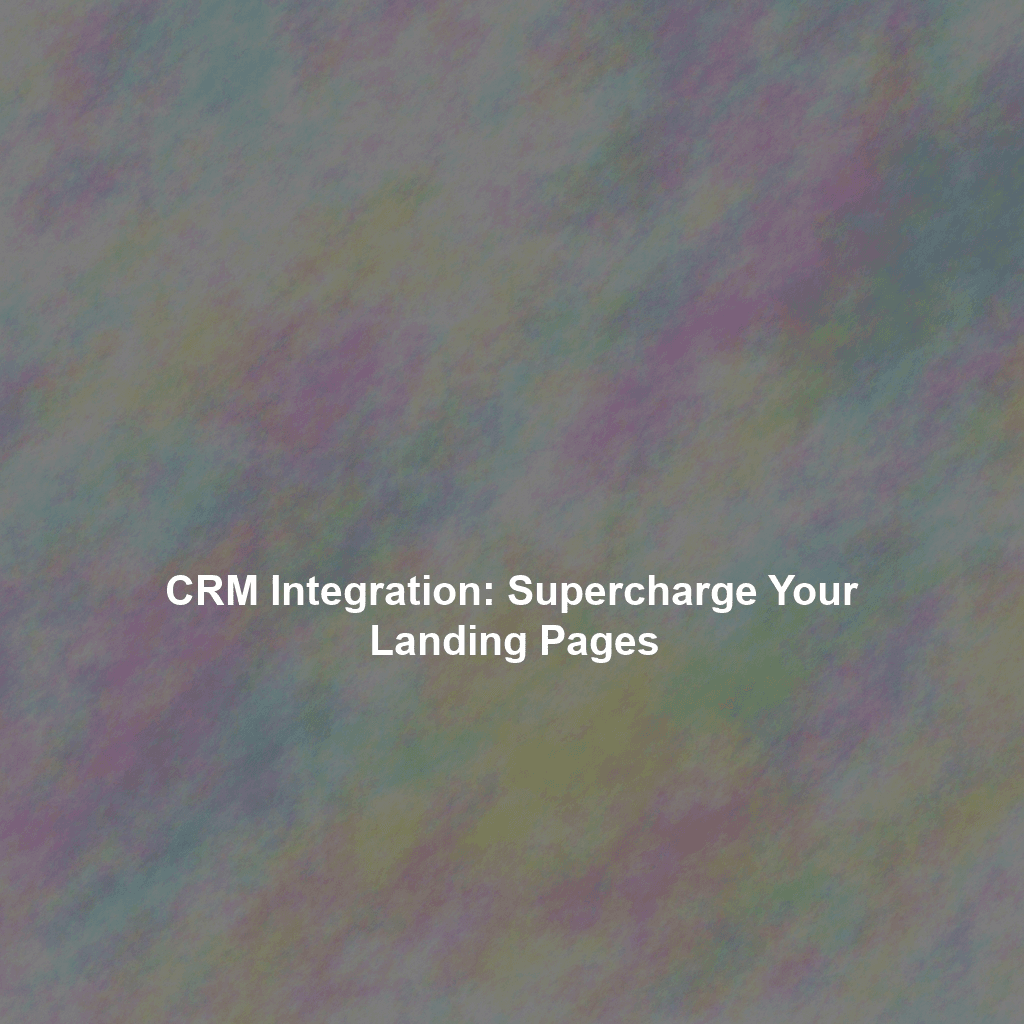Why Integrate Your Landing Pages with a CRM?
Integrating your landing pages with your CRM offers a multitude of benefits that directly impact your sales and marketing performance. Here are some key advantages:
Automated Lead Capture and Data Entry
Manual data entry is time-consuming and prone to errors. When a visitor fills out a form on your landing page, the data should automatically flow into your CRM. This eliminates the need for your team to manually input information, freeing them up for more strategic tasks. Automated lead capture ensures accurate and up-to-date contact information, preventing data silos and improving data integrity.
Improved Lead Qualification and Segmentation
By capturing specific information on your landing page forms, you can automatically qualify and segment leads within your CRM. For example, you might ask about industry, company size, or job title. This information allows you to categorize leads based on their potential value and tailor your follow-up communication accordingly. Effective segmentation ensures that you’re sending the right message to the right people at the right time.
Streamlined Follow-Up Processes
Prompt and personalized follow-up is essential for converting leads into customers. Integrating your landing page with your CRM allows you to automate follow-up sequences based on specific triggers, such as form submissions or downloads. You can set up automated email campaigns, trigger tasks for your sales team, or even personalize website content based on a lead’s previous interactions.
Enhanced Lead Nurturing
Not all leads are ready to buy immediately. Lead nurturing involves building relationships with prospects over time by providing them with valuable content and personalized experiences. By tracking lead activity within your CRM, you can understand their interests and needs, and tailor your nurturing efforts accordingly. This can involve sending relevant blog posts, case studies, or product demos.
Better Tracking and Reporting
Integrating your landing pages with your CRM provides valuable insights into the performance of your marketing campaigns. You can track key metrics such as lead volume, conversion rates, and cost per lead. This data allows you to identify which landing pages are most effective, optimize your campaigns for better results, and make data-driven decisions about your marketing strategy.
How to Integrate Your Landing Pages with a CRM
The specific steps involved in integrating your landing pages with your CRM will vary depending on the platforms you are using. However, here are some general guidelines:
Choose the Right Tools
First, ensure that your landing page builder and CRM system are compatible. Many popular landing page platforms, such as Unbounce, Leadpages, and Instapage, offer direct integrations with leading CRM systems like Salesforce, HubSpot, and Zoho CRM. If a direct integration isn’t available, you can often use a third-party integration tool like Zapier to connect the two systems.
Configure the Integration
Once you’ve chosen your tools, follow the instructions provided by your landing page builder and CRM system to configure the integration. This typically involves authorizing the connection between the two platforms and mapping the fields on your landing page form to the corresponding fields in your CRM.
Test the Integration
Before launching your landing page, thoroughly test the integration to ensure that data is flowing correctly. Submit a test form and verify that the information appears in your CRM. Check for any errors or inconsistencies and troubleshoot as needed.
Set Up Automation and Workflows
Once the integration is working, set up automation and workflows within your CRM to streamline your lead management processes. This might involve creating automated email sequences, assigning tasks to your sales team, or updating lead statuses based on their activity.
Monitor and Optimize
After launching your landing page, continuously monitor the integration and optimize your processes based on the data you collect. Track key metrics such as lead volume, conversion rates, and email engagement. Use this information to identify areas for improvement and fine-tune your campaigns for better results.
Best Practices for Landing Page and CRM Integration
To maximize the effectiveness of your landing page and CRM integration, follow these best practices:
- Keep your forms concise: Only ask for the information you absolutely need to qualify and segment leads. Too many fields can deter visitors from completing the form.
- Use progressive profiling: Gradually collect more information about leads over time through multiple interactions.
- Personalize your messaging: Use the data you collect in your CRM to personalize your landing page content and follow-up communication.
- A/B test your landing pages: Continuously test different elements of your landing page, such as headlines, images, and form fields, to optimize for conversions.
- Segment your leads effectively: Segment leads based on demographics, behavior, and other relevant criteria to deliver targeted and personalized experiences.
Conclusion
Integrating your landing pages with your CRM is a crucial step in optimizing your lead generation and conversion processes. By automating lead capture, streamlining follow-up, and enhancing lead nurturing, you can significantly improve your marketing ROI. By following the steps and best practices outlined in this article, you can ensure that your landing pages are working in harmony with your CRM to drive more leads, close more deals, and grow your business. Investing the time and effort to properly integrate these systems will pay dividends in the long run, leading to more efficient sales and marketing operations and ultimately, increased revenue.
 Skip to content
Skip to content

